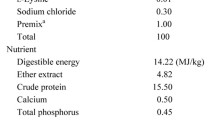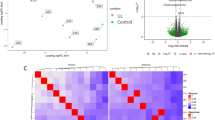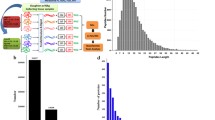Abstract
To investigate the influence on the proteome of chicken skeletal muscles of Selenomethionine (SeMet) use, 36 chicks were fed with SeMet feeding for 35 days. A total of 72 1-day old broiler chicks were randomly allocated into two groups (n = 36/group): the control group (C group), the SeMet supplemented group (SeMet group). The Selenium (Se) concentrations of skeletal muscles from the chicks with basal diet (negative control group) and SeMet feeding were found to be 0.01 mg/kg and 0.40 mg/kg, respectively. The skeletal muscles from the two groups were investigated using isobaric Tags for Relative and Absolute Quantitation (iTRAQ), coupled with liquid chromatography-tandem mass spectrometry (LC–MS/MS) analysis. This proteomic analysis identified proteins that were differentially expressed between the two groups. A total of 3564 proteins from the SeMet and the control (C) groups at 35 days were analyzed. 86 proteins were found by iTRAQ to be differentially expressed in the SeMet group, including 38 up-regulated proteins and 48 down-regulated proteins. These differential proteins were later identified as being mainly involved in antioxidant and enzyme-regulating activities. Fluorescent quantitative PCR(qPCR) and Western blot analyse proved to be consistent with the results of iTRAQ identification. The differentially expressed proteins (DEPs) identified in our work could be specific biomarkers related to SeMet intake in chicks. SeMet intake may strengthen antioxidant activity through Rap1/mitogen-activated protein kinases (MAPK)/extracellular signal-regulated kinase (ERK) signal pathways.






Similar content being viewed by others
References
An X, Zhou A, Yang Y, Wang Y, Xin R, Tian C, Wu Y (2016) Protective effects of gallic acid against NiSO4-induced toxicity through down-regulation of the Ras/ERK signaling pathway in Beas-2B cells. Med Sci Monit 22:3446–3454
Brzački V, Mladenović B, Dimić D, Jeremić L, Živanović D, Djukić D, Stojanović NM, Sokolović DT (2019) Comparison between the effects of selenomethionine and S-adenosylmethionine in preventing cholestasis-induced rat liver damage. Amino Acids 51(5):795–803
Chan LP, Liu C, Chiang FY, Wang LF, Lee KW, Chen WT, Kuo PL, Liang CH (2017) IL-8 promotes inflammatory mediators and stimulates activation of p38 MAPK/ERK-NF-κB pathway and reduction of JNK in HNSCC. Oncotarget 8(34):56375–56388
Chen J, Pan T, Wan N, Sun Z, Zhang Z, Li S (2017) Cadmium-induced endoplasmic reticulum stress in chicken neutrophils is alleviated by selenium. J Inorg Biochem 170:169–177
Di Dato C, Gianfrilli D, Greco E, Astolfi M, Canepari S, Lenzi A, Isidori AM, Giannetta E (2017) Profiling of selenium absorption and accumulation in healthy subjects after prolonged l-selenomethionine supplementation. J Endocrinol Invest 40(11):1183–1190
Erkekoglu P, Chao MW, Tseng CY, Engelward BP, Kose O, Kocer-Gumusel B, Wogan GN, Tannenbaum SR (2019) Antioxidants and selenocompounds inhibit 3,5-dimethylaminophenol toxicity to human urothelial cells. Arh Hig Rada Toksikol 70(1):18–29
Fan RF, Cao CY, Chen MH, Shi QX, Xu SW (2018) Gga-let-7f-3p promotes apoptosis in selenium deficiency-induced skeletal muscle by targeting selenoprotein K. Metallomics 10(7):941–952
Gao L, Feng Y, Bowers R, Becker-Hapak M, Gardner J, Council L, Linette G, Zhao H, Cornelius LA (2006) Ras-associated protein-1 regulates extracellular signal-regulated kinase activation and migration in melanoma cells: two processes important to melanoma tumorigenesis and metastasis. Cancer Res 66(16):7880–7888
Gong ZG, Wang XY, Wang JH, Fan RF, Wang L (2019) Trehalose prevents cadmium-induced hepatotoxicity by blocking Nrf2 pathway, restoring autophagy and inhibiting apoptosis. J Inorg Biochem 192:62–71
Guo D, Zhu Q, Zhang H, Sun D (2014) Proteomic analysis of membrane proteins of vero cells: exploration of potential proteins responsible for virus entry. DNA Cell Biol 33:20–28
Hu S, Zuo H, Qi J, Hu Y, Yu B (2019) Analysis of effect of schisandra in the reatment of myocardial infarction based on three-mode gene ontology network. Front Pharmacol 20(10):232
Huang JQ, Ren FZ, Jiang YY, Xiao C, Lei XG (2015) Selenoproteins protect against avian nutritional muscular dystrophy by metabolizing peroxides and regulating redox/apoptotic signaling. Free Radic Biol Med 83:129–138
Jin X, Jia T, Liu R, Xu S (2018) The antagonistic effffect of selenium on cadmium-induced apoptosis via PPAR-γ/PI3K/Akt pathway in chicken pancreas. J Hazard Mater 357:355–362
Kanehisa M, Goto S, Sato Y, Furumichi M, Tanabe M (2012) KEGG for integration and interpretation of large-scale molecular data sets. Nucleic Acids Res 40:109–114
Kieliszek M, Błażejak S, Bzducha-Wróbel A, Kot AM (2019) Effect of selenium on growth and antioxidative system of yeast cells. Mol Biol Rep. https://doi.org/10.1007/s11033-019-04630-z
Koo DCE, Bonneau R (2019) Towards region-specific propagation of protein functions. Bioinformatics 35(10):1737–1744
Krysiak R, Kowalcze K, Okopień B (2019) The effect of selenomethionine on thyroid autoimmunity in euthyroid men with hashimoto thyroiditis and testosterone deficiency. J Clin Pharmacol. https://doi.org/10.1002/jcph.1447
Liu Z, Qu Y, Wang J, Wu R (2016) Selenium deficiency attenuates chicken duodenal mucosal immunity via activation of the NF-κb signaling pathway. Biol Trace Elem Res 172:465–473
Liu R, Jia T, Cui Y, Lin H, Li S (2018a) The protective effect of selenium on the chicken pancreas against cadmium toxicity via alleviating oxidative stress and autophagy. Biol Trace Elem Res 184(1):240–246
Liu Z, Yao X, Du J, Song B, Zhang F (2018b) Selenium deficiency augments the levels of inflammatory factors and heat shock proteins via the redox regulatory pathway in the skeletal muscles of mice. Biol Trace Elem Res 182(2):309–316
Liu Z, Zhang F, Lu P, Zhao R, Zhang H, Song B, Li L, Wu Z, Wu R (2019) Selenium-yeast alleviated inflammatory damage caused by lead via inhibiting Ras/ERK pathway and inflammatory factors in chicken skeletal muscles. Biol Trace Elem Res 190(2):493–500
Østergaard O, Follmann F, Olsen AW, Heegaard NH, Andersen P, Rosenkrands I (2016) Quantitative protein profiling of chlamydia trachomatis growth forms reveals defense strategies against tryptophan starvation. Mol Cell Proteomics 15(12):3540–3550
Pillay TS, Makgoba MW (1992) Enhancement of epidermal growth factor (EGF) and insulin-stimulated tyrosine phosphorylation of endogenous substrates by sodium selenate. FEBS Lett 308(1):38–42
Sandberg A, Lindell G, Källström BN, Branca RM, Danielsson KG, Dahlberg M, Larson B, Forshed J, Lehtiö J (2012) Tumor proteomics by multivariate analysis on individual pathway data for characterization of vulvar cancer phenotypes. Mol Cell Proteomics. https://doi.org/10.1074/mcp.M112.016998
Sun Z, Xu Z, Wang D, Yao H, Li S (2018) Selenium deficiency inhibits differentiation and immune function and imbalances the Th1/Th2 of dendritic cells. Metallomics 10(5):759–767
Wan N, Xu Z, Liu T, Min Y, Li S (2018) Ameliorative effects of selenium on cadmium-induced injury in the chicken ovary: mechanisms of oxidative stress and endoplasmic reticulum stress in cadmium-induced apoptosis. Biol Trace Elem Res 184(2):463–473
Wang J, Liu Z, He X, Lian S, Liang J, Yu D, Sun D, Wu R (2018) Selenium deficiency induces duodenal villi cell apoptosis via an oxidative stress-induced mitochondrial apoptosis pathway and an inflammatory signaling-induced death receptor pathway. Metallomics 10(10):1390–1400
Xu Z, Jin X, Pan T, Liu T, Wan N, Li S (2017) Antagonistic effects of selenium on cadmium-induced apoptosis by restoring the mitochondrial dynamic equilibrium and energy metabolism in chicken spleens. Oncotarget 8(32):52629–52641
Ye H, Sun L, Huang X, Zhang P, Zhao X (2010) A proteomic approach for plasma biomarker discovery with 8-plex iTRAQ labeling and SCX-LC-MS/MS. Mol Cell Biochem 343:91–99
Zhang W, Zhang R, Wang T, Jiang H, Guo M, Zhou E, Sun Y, Yang Z, Xu S, Cao Y, Zhang N (2014) Selenium inhibits LPS-induced pro-inflammatory gene expression by modulating MAPK and NF-κB signaling pathways in mouse mammary epithelial cells in primary culture. Inflammation 37:478–485
Zhang L, Jiang H, Xu G, Chu N, Xu N, Wen H, Gu B, Liu J, Mao S, Na R, Jing Y, Ding Q, Zhang Y, Wang L (2016) iTRAQ—based quantitative proteomic analysis reveals potential early diagnostic markers of clear-cell renal cell carcinoma. Biosci Trends 10(3):210–219
Zhang ZH, Wu QY, Chen C, Zheng R, Chen Y, Ni JZ, Song GL (2018) Comparison of the effects of selenomethionine and selenium-enriched yeast in the triple-transgenic mouse model of Alzheimer’s disease. Food Funct 9(7):3965–3973
Acknowledgements
This work was supported by grants from the National key research and development program of the 13th 5-year plan (2016YFD0501203), Foundation of National Natural Science Project, P.R. China (31472249;31772789), Foundation Project of Heilongjiang province natural (No. H2017038), and the Startup Foundation for the Doctors in Heilongjiang Bayi Agricultural University (Grant No. XDB-2017-18). Heilongjiang Bayi Agricultural University Team Support Program for San Heng San Zong (TDJH201905) and Heilongjiang Bayi Agricultural University Support Program for San Heng San Zong (ZRCPY201909). The authors wish to thank the study participants and Jilin University for their contributions to this study. All of the authors have read the manuscript and have agreed to submit it, in its current form, for consideration for publication.
Author information
Authors and Affiliations
Corresponding author
Ethics declarations
Conflict of interest
All authors declare that they have no conflict of interest.
Additional information
Publisher's Note
Springer Nature remains neutral with regard to jurisdictional claims in published maps and institutional affiliations.
Electronic supplementary material
Below is the link to the electronic supplementary material.
Rights and permissions
About this article
Cite this article
Liu, Z., Zhang, F., Cui, L. et al. Quantitative proteomic analysis reveals that the Rap1/MAPK/ERK pathway is inhibited through selenomethionine strengthening antioxidant activity. Biometals 33, 45–64 (2020). https://doi.org/10.1007/s10534-019-00229-w
Received:
Accepted:
Published:
Issue Date:
DOI: https://doi.org/10.1007/s10534-019-00229-w




